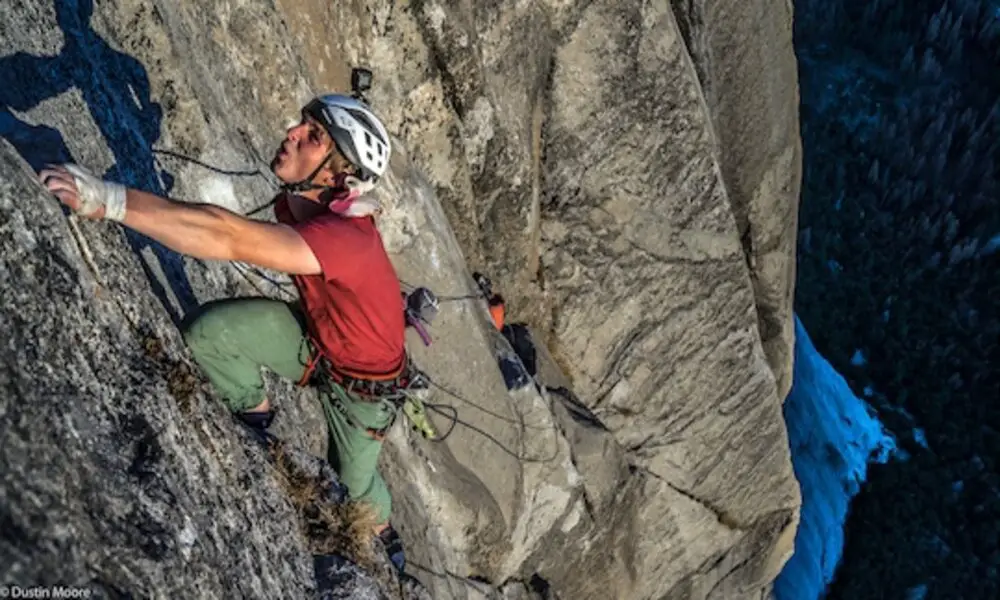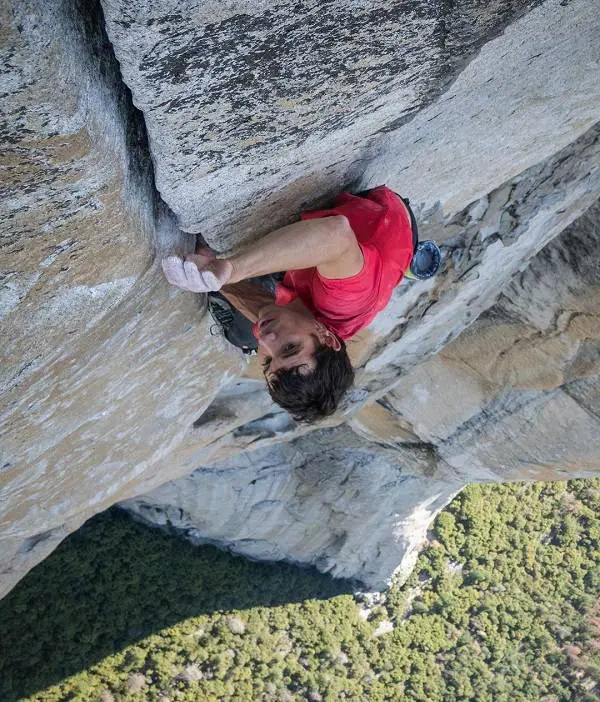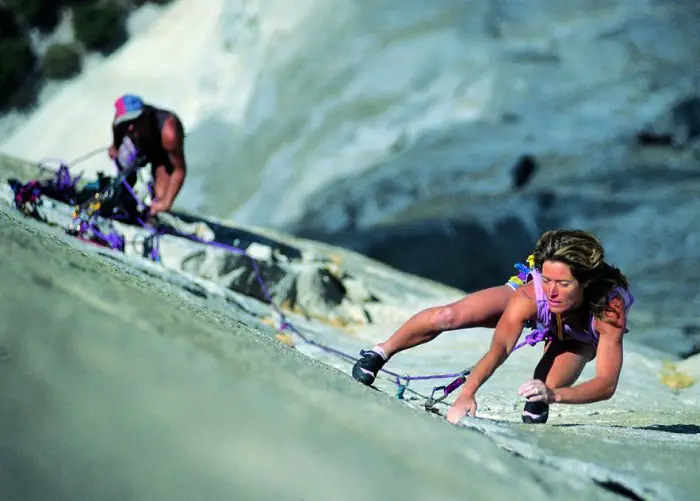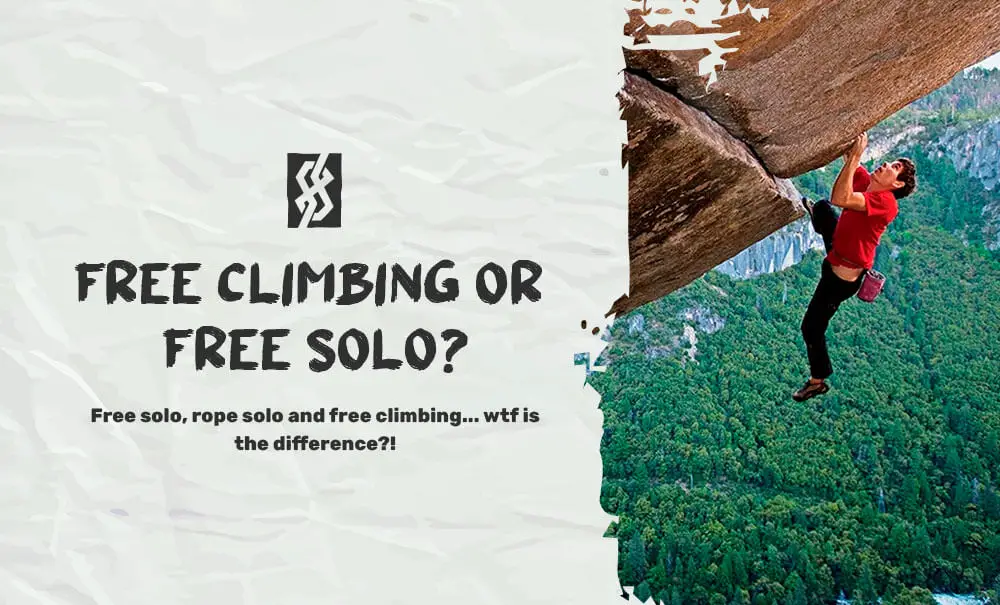Many people will use the terms free solo, solo, and free climbing interchangeably. It is a common misconception that these terms all refer to the same thing.
In reality, they each have distinct meanings that are oftentimes vastly different from each other. In this article, I will do my best to clear up the confusion, so you don’t freak out thinking your friend won’t use a rope when they tell you they’re going free climbing.
What Is Free Climbing?
In rock climbing, there are two main strategies for ascending a face. One is free climbing and one is aid climbing. It is easier to understand the distinction of free climbing when you first understand aid climbing.
When aid climbing, the climber gets up the wall by any means necessary. They will pull on gear, use portable ladders, and ascend ropes – anything goes as long as it contributes to vertical progress. This is the method of climbing used for The Nose Speed Record.

Free climbing implies the climber is solely using their hands and feet on the rock. Rather than pulling on ropes and gear, the climber will only use their body’s connection with the features of the cliff.
This does not mean, however, that the climber doesn’t have a rope on – simply that they aren’t using it to move up. Ropes and gear are still used to protect falls and build anchors.
Free climbing is the most popular form of climbing today. If you’ve gone to a climbing gym you’ve free-climbed. If you’ve gone sport climbing or bouldering, you’ve free climbed. Free climbing is the specific term that typically comes to mind when people imagine climbing.
What Is Solo Climbing?
Soloing is a bit of an umbrella term; it can refer to a few different things. All it really implies, though, is that a climber is ascending the wall by themself. This can mean that they don’t have a rope on however, there are also protected methods of soloing, like rope soloing.

For example, when rope soloing, as you might imagine from the name, the climber will use a rope. When doing this, they will have to belay themself and climb each pitch twice – once to set the rope and a second time to clean the gear. It can be done with either free climbing or aid climbing techniques.
This is definitely not a discipline for the impatient! It takes a lot of time and persistence. You may ask why not just climb with a partner? While I personally agree, the avid soloist often enjoys the feeling of freedom and self-reliance that comes with climbing a wall completely self-supported.
What is Free Solo Climbing?
Free soloing combines the previous two terms we’ve discussed. When free soloing, the climber is alone on the wall, free climbing, with no rope. This is the most dangerous form of climbing as any mistake resulting in a fall leads to certain injuries or death.
So why free solo? The dedicated free soloist usually views free soloing as the purest, freest, and most efficient form of climbing and chases the unique feeling it can bring.
Free soloists also typically have unique perspectives on risk-taking and are able to justify their seemingly dangerous actions. The most notorious free soloists in the world are Alex Honnold and Dean Potter.

In an interview with National Geographic speaking about risk, Honnold stated “So many people condemn me for risk-taking, but I find it sort of hypocritical because everybody takes risks.” He continues, “Even the absence of activity could be viewed as a risk. If you sit on the sofa for your entire life, you’re running a higher risk of getting heart disease and cancer.”
The level of risk any individual is taking is a subjective experience. When I see Honnold 2,000 feet off the ground climbing 5.13 on El Capitan, it certainly strikes me as incredibly risky. However, he obviously has a very different interpretation of this risk. At the end of the day, anybody interested in pursuing free soloing should have a serious conversation with themself about the likelihood of potential consequences, their level of acceptance of these consequences, and their motivations behind doing it.
Solo vs Free Solo
By now you should have a pretty clear understanding of the meaning behind these different terms and you should now know the difference between solo vs free solo vs free climbing. So is there an overlap between them? Certainly! These terms are categories. Each one has some room for nuance.
Soloing can be done in free or aid styles. Free climbing can be done with or without a rope. Free soloing, on the other hand, is pretty definitive. If you are free climbing solo with a rope, free soloing seems like a pretty aptly descriptive term, but you should probably refer to it as free rope soloing to avoid freaking out your friends and family too much.

The common misconception around these terms is that free climbing and soloing always refer to climbing ropeless. While they potentially can mean that, it is only when they are used in conjunction with each other that they do with certainty.
Within the terms of free climbing and soloing, there are numerous other forms of climbing that could be referred to. Hopefully, this article cleared up any confusion around these terms. Stay safe and free climb on!
Header Image: ©Jimmy Chin




Great explanation – thanks!
Hey Esther, glad to hear you found it helpful 🙂
Thank you for this excellent explanation. I have one minor doubt I’d like to clear. When you say
“The common misconception around these terms is that free climbing and soloing always refer to climbing ropeless.” I get that. But then
“While they potentially can mean that, it is only when they are used in conjunction with each other that they do with certainty”
I’m struggling to fully understand this. If “free” means without aid and “solo” means without a partner, then combining “free” and “solo” still doesn’t have to mean ropeless climbing. Is this right?
Mario
Hey Mario, it can be confusing to get your head around it. The words ‘Free + Climbing’ together mean climbing without aid. On it’s own, the term ‘free’ doesn’t necessarily mean climbing without aid, but it also doesn’t mean climbing with no protection at all. It’s only when the word ‘free’ is used with another one do we get a better idea of what type of climbing we are talking about.
When it comes to free solo, the term ‘free’ here indicates some sort of climbing without equipment and the term ‘solo’ indicates you are doing it alone. So, together, free solo = climbing ropeless. I hope this helped explain it a bit better! I will also update the article to make it clearer 🙂